The Monarch Ranch
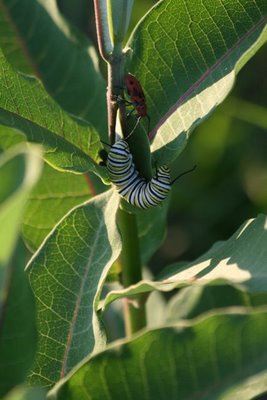
Season of mists and mellow fruitfulness,
Close bosom-friend of the maturing sun;
Conspiring with him how to load and bless
With fruit the vines that round the thatch-eves run;
To bend with apples the moss'd cottage-trees,
And fill all fruit with ripeness to the core
From John Keats' "To Autumn," written September 19, 1819
Close bosom-friend of the maturing sun;
Conspiring with him how to load and bless
With fruit the vines that round the thatch-eves run;
To bend with apples the moss'd cottage-trees,
And fill all fruit with ripeness to the core
From John Keats' "To Autumn," written September 19, 1819
Fruiting and ripening is Autumn's theme. I've been bursting with the desire to tell you about our monarch ranch. But it takes time to gather the images and thoughts that I need to tell a satisfying story.
It starts with the Monarch Ranch, a coffee-table-sized area next to our pond. At first, it was just a plant or two of common milkweed (Asclepias syriaca) coming up and quickly spreading. Uh-oh. Milkweed is an aggressive invader of garden space, and my first instinct was to pull it and keep pulling it. Which I did, and what I got for my efforts was sticky white sap on my hands and more milkweed.
It was here, it was queer, and it was time to get used to it. I decided that I liked the buttery scent of its flower heads, which look like balls of pink cake decorations. I liked the masses of fritillaries, silver-spotted skippers, admirals, ladies, swallowtails and duskywings they attracted.
These are great spangled fritillaries.
But there was a problem. Along about July, after the gorgeous honey-scented blooms had dropped, the milkweed stand (for it was by now a hearty stand, a battery of plants) completely obscured my water garden. What's the point of having a water garden if you can't see it from the deck?
So one fine day I went down with a clippers and lopped the whole lot of them off. Pulling them was futile; they'd just resprout.

Smiling for Phoebe, who's behind the camera. Also smiling because I can see my pondlet again.
Before cutting each plant, I checked it carefully for monarch eggs and caterpillars. Nothing yet. July's a bit early for egg laying here.
When I was done, I had a huge heavy pile of plants to haul to the compost.
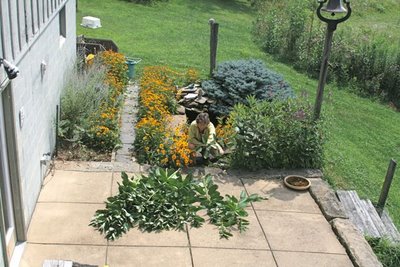 That's that. Well, sort of. Within a couple of weeks, the roots had sent up healthy, tender new shoots. They were going to reconquer the water garden.
That's that. Well, sort of. Within a couple of weeks, the roots had sent up healthy, tender new shoots. They were going to reconquer the water garden.
Ahh, but this time they didn't get so tall, nor did they bloom. They just kept putting out leaf after tender leaf. And the monarchs noticed. Monarchs like tender new leaves, unlike milkweed tussock moth caterpillars, which can eat the tough old holey ones.
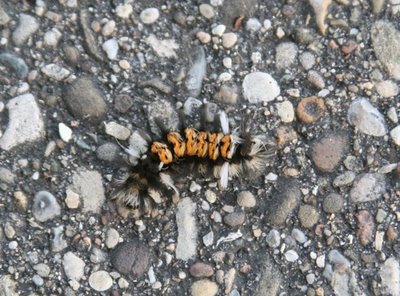 There was a monarch oviposition frenzy that summer--26 caterpillars at one time in this tiny area--and the idea for the Indigo Hill Monarch Ranch was born. These pictures were all taken this year, but the ritual has been the same since its inception. Wait for the milkweed flowers to fade and fall in late July, lop the plants down to ground level, stand back and wait for the new shoots to emerge. Enjoy your caterpillar ranch.
There was a monarch oviposition frenzy that summer--26 caterpillars at one time in this tiny area--and the idea for the Indigo Hill Monarch Ranch was born. These pictures were all taken this year, but the ritual has been the same since its inception. Wait for the milkweed flowers to fade and fall in late July, lop the plants down to ground level, stand back and wait for the new shoots to emerge. Enjoy your caterpillar ranch.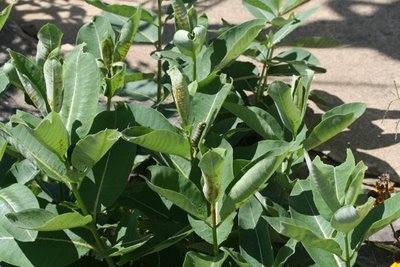
What could have been an aggressive pest has been tamed by the cutback. It's not spreading much anymore (we'll disregard the shoots that come up in the cracks of the patio...)
But the greater shift has been in my perception of the plant. It's gone from pest status to exalted, as a source of fragrant flowers, fritillaries, and intense joy. Next: the ongoing chrysalis party in our kitchen.
News flash!
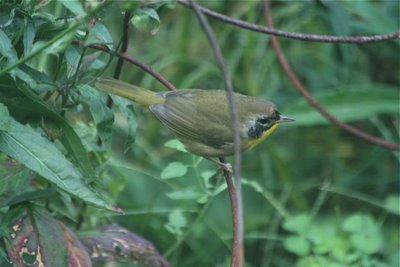
Just a quick message, inserted sideways into the chrysalis talk, to tell you that one of my commentaries, about rescuing a common yellowthroat on a Chicago street, is due to air this afternoon (September 22, 2008) on National Public Radio's All Things Considered. The show starts at 4 pm Eastern, and the commentary could air any time in the succeeding two hours. If you miss it, you can listen to the soundfile here.
Labels: common milkweed, Common yellowthroat, how to raise monarch caterpillars, monarch ranching, Zick on NPR






<< Home